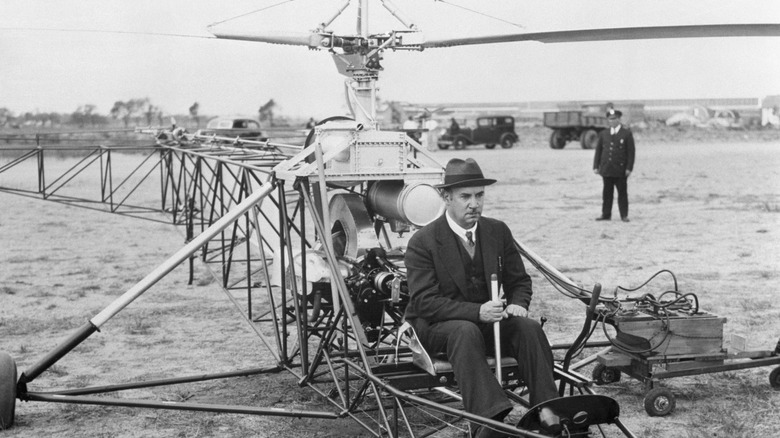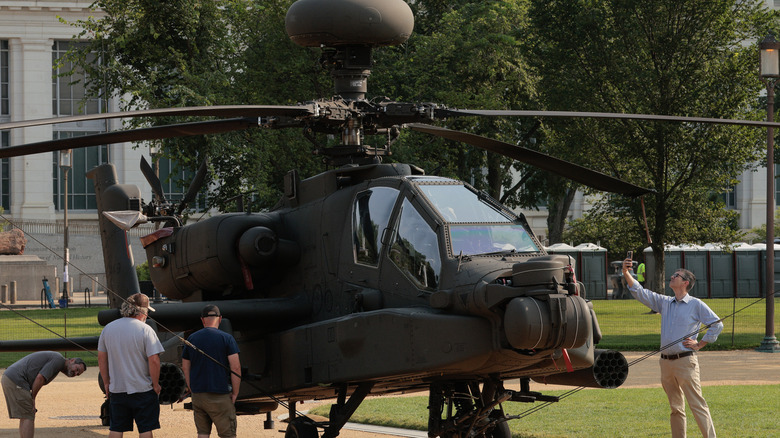What Are Helicopter Blades Made Of?
A little over a century ago, the idea of flying would have been laughable to many. Nonetheless, flying is entirely routine for millions today, and much of the reason that planes and helicopters are capable of getting off the ground and sustaining flight is the material they're made from. Lift is one factor that's key to the flight of all aircraft, and for a helicopter, the rotors are essentially analogous to an airplane's wings. For airplanes, it's the air flowing over the wings that maintains lift, while for a helicopter, it's the rotation of the blades. The crucial components are made of similar materials, with a helicopter's rotor blades generally being constructed today from composite materials.
It's essential that these parts of the aircraft be as strong as they can without adding needless weight, thereby balancing durability and aerodynamic qualities. For a plane's wings, aluminum is a great answer to both of these needs. Helicopters, meanwhile, have been more widely able to incorporate carbon fiber into their rotor blades. Naturally, every model of helicopter is built in different ways, with its own specifications, and so the precise makeup of its blades as well as its body will differ. The formidable Black Hawk helicopter, for instance, has blades composed of "spokes" of titanium and layers of Nomex, a strong and resilient fiber material used in advanced personal protective equipment. Prior to such advancements, though, helicopter blades were made of wood and other materials.
The evolution of helicopter blades over time
The first airplanes were (as is to be expected) rather rudimentary-looking machines. This is primarily because they were often built from wood. This was the case with so many classic aircraft, such as the British de Havilland Mosquito, a World War II–era plane which de Havilland hoped would be lighter and more maneuverable than its metal-bodied contemporaries. Just as with airplanes, the first helicopters were made predominantly from wood. Leonardo da Vinci's fantastical design of an aerial screw incorporated a sort of skeleton of wood and fabric sails, and though it was more of an experimental concept and wasn't practical as a flying machine, the wood and fabric combination would serve the first helicopters just as well as it did the first airplanes.
As International Aviation Composites Ltd vice president Dana Kerrick puts it in Helicopter Maintenance Magazine, "The first rotor blades had a rather stout spar usually made of Sitka spruce, vertical laminates of birch that offered good impact resistance, and balsa wood for the afterbody which really didn't work that hard except for maintaining the shape of the airfoil." It was a matter of using all the different qualities of various types of wood, thereby making for a more sophisticated aircraft design than you might think at first glance. Nonetheless, wood would fall out of favor as a primary material for constructing helicopters. The major drawback was the inherent difference in every piece of wood, which meant that a pair of blades had to be developed from the very same wood and any issues could render both useless. Thus the more familiar metal helicopter was developed.
Helicopters of metal and composite materials
Igor Sikorsky is one of the little-known heroes of military aviation. He was the founder of The Sikorsky Manufacturing Corporation a century ago and was pivotal in making the helicopter a practical and viable mode of transportation. His VS-300, developed at the end of the 1930s, prominently featured both wooden and metal elements. It had a frame of steel, while the Sikorsky Archives notes that "the main rotor blade had a spruce wooden spar extending from root to tip. The leading edge consisted of lamination of spruce, balsa, and mahogany." Meanwhile, the main body of the tail's blades was made of poplar and maple.
Early in the 1940s, the Hiller XH-44 would become the first helicopter to fly with rotors that were made exclusively of metal. This was in an attempt to keep them as strong as they needed to be for a coaxial helicopter, and highlighted the fact that metal made for stronger blades. Later, helicopters would incorporate blends of different metals to tailor their blades to their specific purpose. The iconic Apache military helicopter, for instance, has blades of fiberglass and spars of stainless steel. Titanium is also an excellent addition to the metal elements of the Apache's blades, limiting weight while not sacrificing durability: Titanium weighs slightly over half as much as an equivalent amount of steel, while being just as strong. Though comparatively expensive and challenging to work with, owing to its resilient nature, this metal can be invaluable in keeping pilots and crew members safe by preventing damage to the blades.


